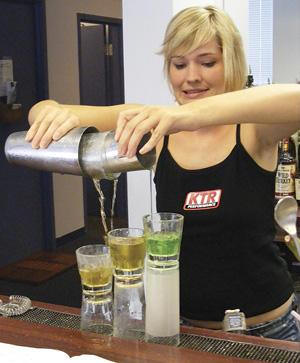 |
|
Budding Bartenders Find a Home in Clarendonby KRISTEN ARMSTRONG, Staff Writer
|
|
| Think of educational institutions near
Clarendon, and you might come up with Key Elementary or George Mason
University. But there's one that might not immediately come to mind: the
Professional Bartending School. Located on the corner of Wilson Boulevard and North Barton Street, it is one of the few bartending schools in the area, and this year is celebrating four decades in operation. “We've been around for 40 years,” said the school's director Crystal Guess in a recent interview. “We've been at two or three locations, but we've been booming since we've been in Arlington.” The school offers a 40-hour bartending course that can be taken in one, two or five weeks, depending on what works best for the student. In addition to covering the cost of classes, the $595 tuition includes the textbook, certifications, help with job placement and lifetime access to the school's facilities. Over the course of six drink lessons, two lectures and eight required hours of practice time, students learn to differentiate between 150 and 200 different drinks. Students must then pass a written exam, as well as a speed test (students must make 12 drinks in less than seven minutes) to graduate. While many of the approximately 50 students who come through the school each week are in their mid-20s to early-30s, the school attracts a diverse crowd. “We get people who are frustrated with their full-time jobs - Realtors, accountants, teachers home for the summer, students paying their way through school. We get some retirees and some straight out of high school,” Guess said. “[Bartending] is a way to make money, make drinks and make friends.” “I got into mixing drinks working at Starbucks,” said student Jack Baukin. “This is an upgrade.” The school accepts students ages 18 and older. Laws in Virginia and the District of Columbia require bartenders to be 21 years of age, while laws in Maryland vary, some permitting individuals to bartend at age 18. Why take a course to become a bartender, when you could work your way up in a bar or restaurant? Taking a course allows budding bartenders to be exposed to a wider variety of techniques and drinks, Guess said. Bartenders who work their way up in a bar or restaurant may know that particular bar or restaurant's drinks very well, but risk not knowing many other drinks, she said. Plus, getting lessons from a bartender while on the job doesn't always foster the best learning environment. “At a school, you're allowed to make mistakes,” Guess said. A bartender teaching someone while on the job “will get frustrated baby-sitting you.” “We're trying to create a level of comfort, and it gives us the chance to explore different flavors,” said instructor Moe Harris. (Harris also offers private lessons in “flare” bartending techniques, the kind found in films such as “Cocktail” and “Coyote Ugly.”) While the instructors like to keep things fun with a relaxed, social atmosphere (some students have even met their future spouses during the course), giving students the skills and knowledge to fulfill one of their dreams is at the heart of their mission. “It's great seeing them learn how to bartend, then hear that they got a job,” Guess said. “We're living up to our promise to people.” For more information on the Professional Bartending School, see the Web site at www.bartending-school.com. |
 Victoria Stone practices the "Stop Light" shot during bartending class. (Photo by Kristen Armstong) |